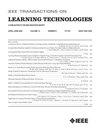MSC-Trans: A Multi-Feature-Fusion Network With Encoding Structure for Student Engagement Detecting
IF 2.9
3区 教育学
Q2 COMPUTER SCIENCE, INTERDISCIPLINARY APPLICATIONS
引用次数: 0
Abstract
Classroom engagement is a critical factor for evaluating students' learning outcomes and teachers' instructional strategies. Traditional methods for detecting classroom engagement, such as coding and questionnaires, are often limited by delays, subjectivity, and external interference. While some neural network models have been proposed to detect engagement using video data, they generally rely on fixed feature combinations, which fail to capture the logical connections and temporal dynamics of engagement.To address these challenges, this article introduces the MSC-Trans Engagement Detecting Network, a temporal multimodal data fusion framework that integrates a convolutional neural network (CNN) and a multilayer encoder–decoder structure. The proposed network includes two key components: first, a multilabel classifier based on ResNet and Transformer, which embeds labels into image features extracted by the CNN for high-precision classification through background inference, second, a temporal feature fusion module, which leverages an encoder–decoder structure to integrate multimodal features over time, enabling stable tracking of classroom engagement. Meanwhile, this open framework allows users to freely select feature combinations for temporal fusion based on specific scenarios and needs.The MSC-Trans Engagement Detecting Network was validated on the DAiSEE dataset, augmented with real classroom data. Experimental results demonstrate that the proposed method achieves state-of-the-art performance in continuous engagement tracking metrics, with flexible and scalable feature selection. This work offers a robust and effective approach for advancing engagement detection in educational settings.基于编码结构的多特征融合网络的学生参与度检测
课堂参与是评价学生学习成果和教师教学策略的关键因素。检测课堂参与度的传统方法,如编码和问卷调查,往往受到延迟、主观性和外部干扰的限制。虽然已经提出了一些神经网络模型来使用视频数据检测参与度,但它们通常依赖于固定的特征组合,这无法捕获参与度的逻辑联系和时间动态。为了应对这些挑战,本文介绍了MSC-Trans Engagement detection Network,这是一个时序多模态数据融合框架,集成了卷积神经网络(CNN)和多层编码器-解码器结构。该网络包括两个关键组件:第一,基于ResNet和Transformer的多标签分类器,它将标签嵌入CNN提取的图像特征中,通过背景推理进行高精度分类;第二,时间特征融合模块,它利用编码器-解码器结构随时间整合多模态特征,从而实现对课堂参与度的稳定跟踪。同时,这个开放的框架允许用户根据特定的场景和需求自由选择特征组合进行时间融合。msc - transengagement检测网络在DAiSEE数据集上进行了验证,并辅以真实的课堂数据。实验结果表明,该方法具有灵活和可扩展的特征选择能力,在连续交战跟踪指标方面达到了最先进的性能。这项工作为推进教育环境中的参与检测提供了一种强大而有效的方法。
本文章由计算机程序翻译,如有差异,请以英文原文为准。
求助全文
约1分钟内获得全文
求助全文
来源期刊

IEEE Transactions on Learning Technologies
COMPUTER SCIENCE, INTERDISCIPLINARY APPLICATIONS-
CiteScore
7.50
自引率
5.40%
发文量
82
审稿时长
>12 weeks
期刊介绍:
The IEEE Transactions on Learning Technologies covers all advances in learning technologies and their applications, including but not limited to the following topics: innovative online learning systems; intelligent tutors; educational games; simulation systems for education and training; collaborative learning tools; learning with mobile devices; wearable devices and interfaces for learning; personalized and adaptive learning systems; tools for formative and summative assessment; tools for learning analytics and educational data mining; ontologies for learning systems; standards and web services that support learning; authoring tools for learning materials; computer support for peer tutoring; learning via computer-mediated inquiry, field, and lab work; social learning techniques; social networks and infrastructures for learning and knowledge sharing; and creation and management of learning objects.
 求助内容:
求助内容: 应助结果提醒方式:
应助结果提醒方式:


